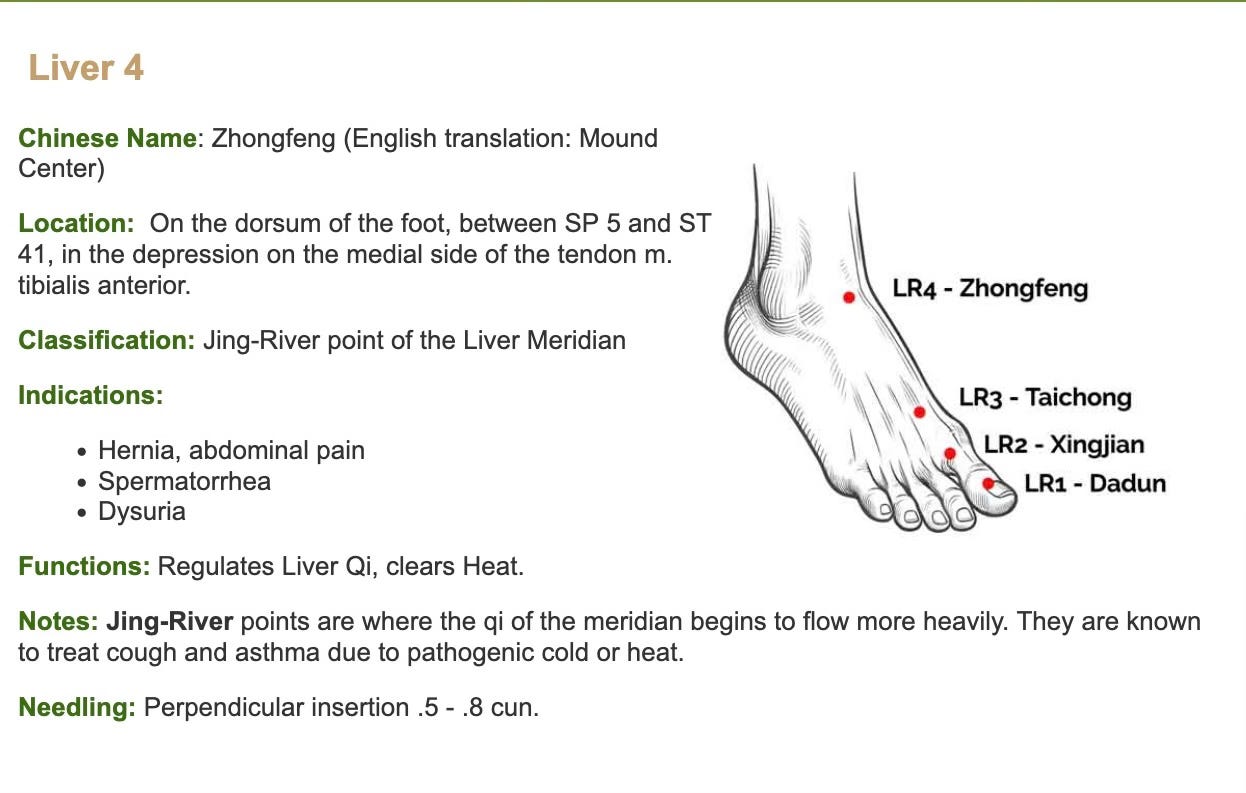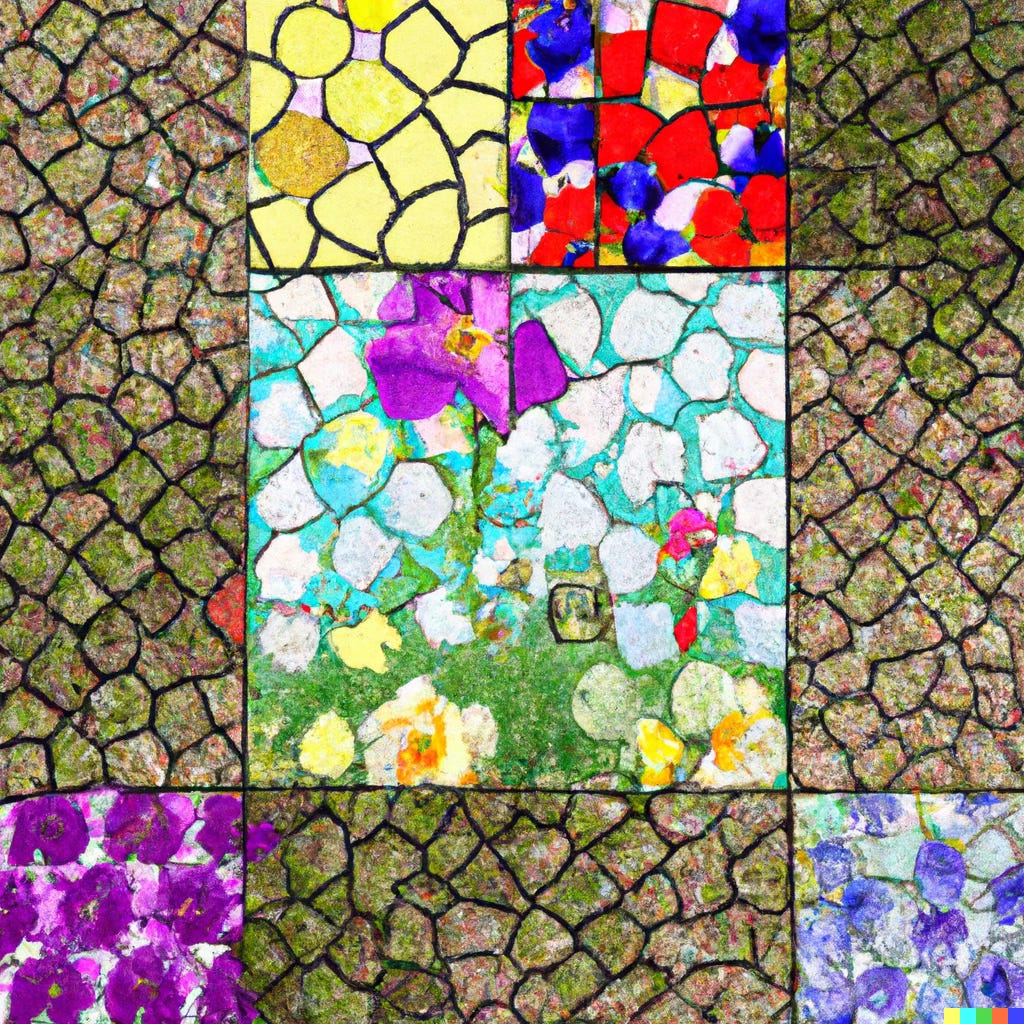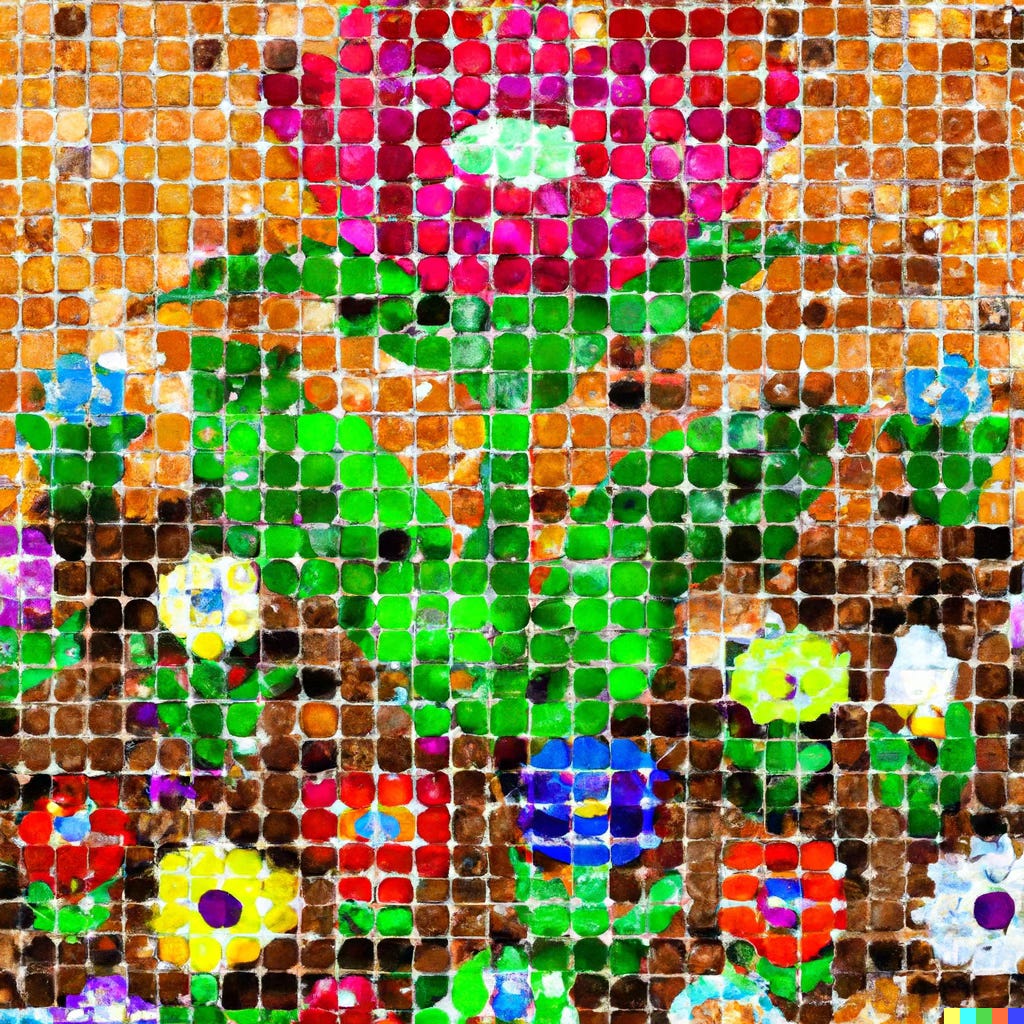What Do Acupuncture Points Do?
part two: it's all about context (with a side of quantum field theory)
Picking up where we left off: what do acupuncture points do?
(Especially if we’re not considering them equivalent to Chinese herbs in Traditional Chinese Medicine?)
It’s not a secret that I’m very frustrated with the TCM standardization of acupuncture in the US. (See: American Chinese Medicine by Tyler Phan.) But also, I get the appeal of standardization, especially for schools. It’s much easier to teach acupuncture if you can give students a nice, neat list of what each acupuncture point does and then tell them to memorize those functions. How would you teach this stuff otherwise?
Good question! This post is about how we do it. Like everything else at POCA Tech, it’s far from perfect, but it works.
Before we had the language of “descriptive vs. prescriptive”, we had the desire to be as honest as possible with our students about what we’ve learned over the years in high volume acupuncture practices. In our experience, a lot of the prescriptive stuff about acupuncture (advice, rules, etc) sounds great when you’re in school (or when you’re using it as marketing) but it often falls apart in the context of treating real humans. The more patients you treat, and the more diverse those patients are, the faster it falls apart. Acupuncture in practice is pretty much the opposite of acupuncture in textbooks. It’s lively, messy, and unpredictable.
As a result of doing a lot of community acupuncture for a lot of years, we’re convinced that acupuncture points do what they do in context. So we teach students to pay attention to the context, in three distinct ways:
First, providing any kind of acupuncture delivers powerful global effects, regardless of individual points.
No matter what points you choose for a treatment, you can count on acupuncture — any acupuncture — to regulate the nervous system and to reduce inflammation. For most people, this means that an acupuncture treatment is likely to feel relaxing in the moment, and also to improve their mood, their energy, and their sleep. Acupuncture in any form reduces stress. Since stress has negative consequences for all systems of the body, acupuncture buffers those impacts. And so people tend to feel better in all kinds of ways. It’s common for patients to come in for one problem and report that acupuncture resolved other problems that they didn’t think to mention. For example: someone comes to the clinic to address acute pain from a sprained ankle but to their surprise, their chronic indigestion improves too. Acupuncture almost always acts more like a shotgun than a laser. As an acupuncturist, there’s only so much you can do to aim it. Even if you were to use only one acupuncture point in a treatment, it would be hard to separate its individual effects from the global impact.
Second, each patient is the context, in their own right. Patients aren’t passive recipients of acupuncture, they’re active participants (regardless of whether they make lifestyle changes).
My coworker Erin forwarded this beautiful newsletter by Maria Popova titled The Kiln and the Quantum of Relationships, which is about “the staggering cathedral of quantum field theory:”
that revolutionary description of how one aspect of reality — one object, one entity, one part of nature — manifests itself to any other. Because every description of a thing is a claim about its nature, at the heart of the theory is the claim that interaction is the fundamental reality of the universe, that there are no entities as such — only dynamic manifestations of which we catch an evanescent glimpse and call that flashing image entity. ... (Physicist Carlo Rovelli writes): “Even if we know all that can be predicted about one object and another object, we still cannot predict everything about the two objects together. The relationship between two objects is not something contained in one or the other of them: it is something more besides.”
I read that and thought, that’s exactly like acupuncture! Every treatment, even when it’s the same points needled on the same person by the same acupuncturist, is a unique encounter. You never know exactly what’s going to happen. People are different on different days, and so are acupuncture points.1
Third, acupuncture points have variable meanings within the context of different clinical approaches to acupuncture.
At POCA Tech we teach multiple clinical approaches because (say it with me now): there is no one right way to do acupuncture. Let’s see if I can describe this aspect of context without getting completely lost in the weeds of acupuncture theory.2
Acupuncture points are (mostly) located along acupuncture channels, and acupuncture students need to learn both the locations of the individual points as well as the pathways of the channels.3 Certain acupuncture points belong to categories known as “transport points”. For example: jing-well, ying-spring, shu-stream, jing-river, and he-sea. These categories are based on an image of qi flowing like water through the channels: it bubbles up at a wellspring, grows from a stream into a river, and merges into a sea. 4
A major task for POCA Tech students is memorizing all the transport points and their categories. But there are different ways to look at transport points: in the context of Five Element theory; in the context of the body’s geography; according to seasonal and hourly correspondences; and of course according to herbalized “point functions.” You can even correlate them to the I-Ching if you want. All of these ways of looking at transport points overlap to some degree and none of them are wrong. Any of them could be a legitimate reason to choose a point.
For example, let’s take Liver 4. In TCM school I learned about Liver 4, but I can’t remember ever using it during my internship.

That’s because its TCM functions weren’t especially exciting. If I wanted to use Liver points in a TCM treatment, I’d almost always choose Liver 3 or Liver 8; maybe Liver 14. Liver 4 was unlikely to make the cut. I memorized it for tests and then forgot about it.
But once I graduated and started learning more clinically effective ways to treat the people I was seeing, I developed real fondness for Liver 4. I found it very useful for treating wrist pain, including some gnarly carpal tunnel cases. I still used Liver 3 and Liver 8 for what I thought of as “Liver-y” problems, and if somebody with wrist pain seemed “Liver-y” to me maybe I’d use Liver 3 AND Liver 4 because why not? It’s okay to use two adjacent points on a channel. Or if my patient seemed “Liver-y” but they complained that their toes were cold (circulation problems are Liver problems!) and they didn’t want to take off their socks, maybe I’d ask them to let me roll their socks down just past their ankles. I’d needle Liver 4 instead of Liver 3 (see diagram above), and I’d appreciate how nice it is to have options.
That’s just scratching the surface of how you can use Liver 4 in different contexts, though.
In acupuncture imaging, the ankle could stand in for the wrist, so that explains why Liver 4 is good for problems like carpal tunnel. But you could also use the foot to represent the head, in which case Liver 4 would land somewhere around the throat, so you could use it to treat a sore throat or a cough. Anything that bends can stand in for anything else that bends, so if the ankle represents the waist, you could use Liver 4 to treat low back pain.
In Balance Method, Liver 4 can be used to balance the Pericardium meridian (there’s your wrist pain again) as well as the Large Intestine, the Gallbladder, the Small Intestine or the Lung meridians. Which would make it a good choice for neck and/or shoulder pain.
In Korean Four Point acupuncture, if a patient has a deficient Liver pulse (which could be associated with any number of complaints, including depression, anxiety, menstrual cramps, and fatigue) Liver 4 would appear in a treatment alongside Kidney 10, Liver 8, and Lu 8 because Liver 4 is the metal point on the wood channel, which makes it the control point for a Liver deficiency problem.
Do you see what I’m getting at? What Liver 4 “does” depends completely on the context of the treatment approach. There’s no wrong way to use Liver 4, unless you insert the needle to an inappropriate depth and injure your patient. (Don’t do that!) This is why a descriptive mindset in relationship to acupuncture points is important, because a prescriptive version just can’t contain all the nuances. As Tyler Phan put it, forcing acupuncture into a narrow, standardized box defeats the purpose of having acupuncture at all.
This inherent flexibility is particularly important for community acupuncturists. In a clinic that has a big, diverse patient base and runs on a shoestring budget, you never know when you might have to make adjustments.
For example: tariffs.
Just like everybody else in the acupuncture profession, we don’t know what’s going to happen with tariffs.5 Fortunately for us, our preferred needles come from South Korea. But if the cost of needles goes up 10% or 20%, the only way for WCA to absorb that cost without raising our prices (which we do NOT want to do, we just did it last year), is to use 10% or 20% fewer needles. Instead of 20 needles in a treatment, maybe we’d use 16.
Both practitioners and patients get attached to certain styles of treatment and habits of practice. It’s easy for people to think that certain points are essential or that more needles are always better. There’s nothing about acupuncture itself, though, that actually backs up that idea. Yes, this newsletter is me giving you a heads up that WCA acupunks and POCA Tech student interns might have to start using fewer needles in their treatments, and we’re going to need everybody to be flexible and open-minded about it. No, I did not expect to invoke quantum field theory to tell you that. The physicists are right: You never know what’s going to happen. One thing we can count on, though, is that acupuncture is always adaptable.
Which is another reason why acupuncture protocols are useful and effective. Even if you’re using the same points over and over, the treatment itself will be unique every time. See also, Manifesting Community: All about Protocols.
Acupuncture theory is nerd heaven. One of the acupuncture profession’s big problems is that people are attracted to the intricate and beautiful theories and they assume that practicing acupuncture is like studying acupuncture — but mostly, it isn’t. And small business is even less like that.
There are people in the acupuncture world (not us) who are determined to find anatomical evidence that acupuncture points and acupuncture channels exist in a way that can be measured and defined by biomedicine. See: Biophysical Characteristics of Meridians and Acupoints: A Systematic Review. That’s not something we get into at POCA Tech.
What’s qi? That deserves its own post. Stay tuned, I’m working on it.
The New York Times just published an article about tariffs, TCM and acupuncture.




Love it. Always love how universal community acupuncture practice is. Eg. I’m always saying to my patients things like, well, that particular treatment may have been just the thing last time but that doesn’t necessarily mean it will do the same thing today, or. Yeah. Many of the things you spoke about about the descriptive nature of how acupuncture points work in this quantum way.